what does it mean to compress os drive
| Forum Stats |
| Fatal error: Phone call to a fellow member function sql_error() on a non-object in /host/world wide web/forums/includes/functions.php on line 558 |
Understanding Compression and the Encrypted File Organization
The Windows XP Professional operating organisation allows for both pinch and encryption natively within the operating system by setting given attributes on the files and folders. Both of these functions are mutually sectional of each other and merely one or the other can exist enacted on a particular file or directory at whatever given fourth dimension.
[NOTES FROM THE FIELD] - What you tin do is compress an entire directory and all of the files and folders within that directory and so get in and elect to encrypt select files which will remove the compression bit from those selections that volition exist come encrypted. A file or folder cannot be both encrypted and compressed at the same fourth dimension under Windows 2000 or XP Professional person natively by the operating organisation itself.
There is a Compressed Folders feature within Windows XP Professional which provides the power to create compressed folders and view their contents much in the style that many other programs such as PKZip and WinZip perform. This article deals with the operating organisation / attribute driven level of compression and not this particular utility.
It is important to note that compressed folders of this nature, created through the use of the Compressed Folders feature within Windows XP Professional, CAN be encrypted on NTFS partitions and Can be compressed (only) on FAT16 and FAT32 partitions.
You can shrink a binder by selecting the folder, right clicking it and choosing Properties. On the GENERAL tab of the properties page y'all would select the Advanced button in club to bring upwards the Advanced Attributes page, as shown below.
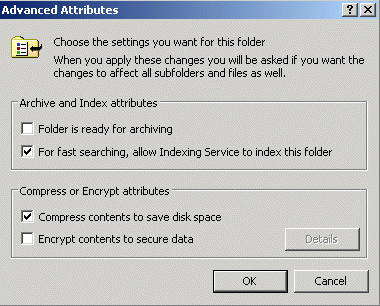
On the Advanced Attributes page you would go down to the Compress or Encrypt attributes section where you can cull one checkbox to compress the contents or the other to encrypt them.
[NOTES FROM THE FIELD] - Strangely enough, the options to target are check boxes, which normally denote the ability to choose more than i selection. (Radio buttons are normally used in a situation where just one selection from a number of given ones tin can be selected.) Regardless of which, if you endeavour to select both, you will find that your second choice in this department undoes your first option.
I call back the determination to program this property page in this way stems from the fact that you lot cannot unselect a radio push button by clicking on it a 2d time as you can a checkbox. (This is just my thought on this. This is not backed up by whatsoever facts.) If you lot desire to make a folder and the contents "normal" by neither encrypting them nor compressing them, you'd clear the checkboxes.
Once yous elect to compress the folder by selecting that checkbox you lot would click OK and information technology would seem as if nothing has happened, and actually, goose egg has. Until y'all click APPLY or OK to the main property canvass, you will not be given any further options for this operation.
At that time, the side by side options are bachelor as shown below.
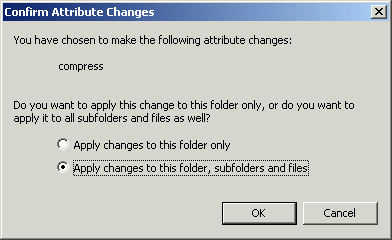
If you elect to apply changes to the folder just, simply the folder itself will become compressed. What this ways is that anything currently in the folder will go on it'southward current pinch state. (In most cases this would mean that the files and other folders inside that folder will remain uncompressed.) Anything added to that binder from that point forwards will become compressed as it is copied to or moved to the binder.
[NOTES FROM THE FIELD] - Any encrypted file that is moved to or copied to that compressed folder will remain encrypted and will Non get compressed and hence unencrypted. If the encrypted file that was moved to that folder is correct clicked and has the encryption aspect removed it will Not become compressed automatically.
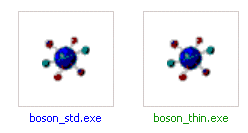
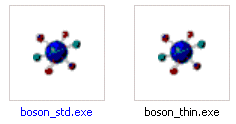
The only way to shrink that file is to individually right click it and choose to shrink it or to MOVE information technology out of and then back into the folder. Simply copying it out to a temporary location and and then dorsum in with the OVERWRITE option will Not cause information technology to become compressed even if changes were fabricated to the copied out version.
This means that if an encrypted document is unencrypted in a compressed folder it will be in a normal land. If another copy of that certificate exists somewhere else on the organisation and it is in a compressed state and editing is performed on it and then saved and then that compressed and updated copy is copied over the older version, that older version will still be uncompressed in that binder that is supposed to compress all new files that are copied in. The updates to the text will be present, only the file volition notwithstanding be uncompressed.
This is because the attributes to the file are non carried over with the changes to the file itself.
This as well works for the reverse, from not compressed to compressed.
If you lot elect to apply changes to the folder and all of the files and subfolders contained within the folder, they will all become compressed.
If you elect to remove compression from the folder itself and choose to make the attribute changes to the folder just, all the files in the binder that were compressed before volition remain compressed as yous move them around the local system.
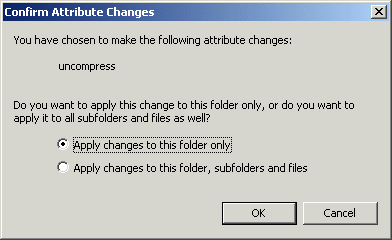
When yous effect changes to the folder and all of the files subfolders contained within, all of the files will be come up uncompressed.
[NOTES FROM THE FIELD] - If there is a file within the folder that is to be uncompressed that is in an encrypted state, it volition stay encrypted every bit the encrypted attribute of that file is not affected by the clearing of the compression attributes of the other files around information technology and the fold it's in.
You tin can select to view compressed and encrypted files in different colors so that you lot know the state of the file by quickly looking at it.
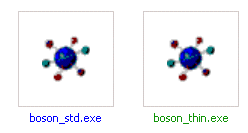
[NOTES FROM THE FIELD] - In the example higher up, the file denoted in blue lettering is compressed and the one in green lettering is encrypted. This can exist ready past going in to the Windows Explorer and choosing Tools and then Folder Options.
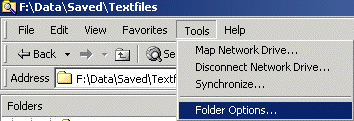
On the View tab of the pop up box is where you would select the Show encrypted of compressed NTFS files in color checkbox to enable this characteristic.
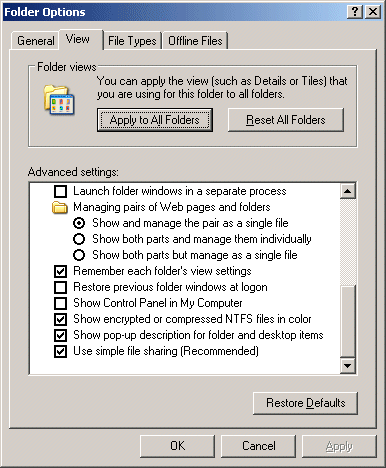
If you re-create an aspect set compressed file to a FAT16 or a FAT32 division or to a floppy disk, it will lose its compression aspect.
The overall rules for compression are equally follows:
- Copying a file within the same NTFS volume causes the file to inherit the compression land of the target folder. When you copy a compressed file to an uncompressed folder, the file is automatically uncompressed.
- Moving a file or folder within the same NTFS volume causes the file or binder to retain its original compression state. When you motility a compressed file to an uncompressed folder, the file remains compressed.
- Copying a file or folder from 1 NTFS volume to another causes the file or folder to inherit the compression land of the target folder. When you copy a compressed file from one NTFS book to another, where the target binder is uncompressed, the file is automatically uncompressed.
- Moving a file or binder from one NTFS volume to anothercauses the file or binder to inherit the compression state of the target folder. Windows XP Professional person treats a move (cut and paste) as a copy and a delete, the files inherit the pinch state of the target folder.
- Moving or copying a file or folder to a FAT16 or FAT32 volume - Windows XP Professional supports attribute driven compression just on the NTFS file organisation, and then when you motility or copy a compressed NTFS file or folder to a FAT volume, (12, 16 or 32) Windows XP Professional will automatically uncompress the file or binder. If you need to maintain some level of compression in this scenario you tin can utilise the Compressed Folders characteristic within Windows XP Professional.
- Moving or copying a compressed file or folder to a floppy disk or other removable media - Windows XP Professional supports attribute driven compression only on the NTFS file system, then when you move or copy a compressed NTFS file or binder to most types of removable media, Windows XP Professional will automatically uncompress the file or binder because most forms of removable media do not support the NTFS file system. If y'all demand to maintain some level of pinch in this scenario you can use the Compressed Folders feature within Windows XP Professional.
You lot should likewise attempt to shrink data that is non often modified, as there is some system overhead to uncompressing the files to open them for editing so compressing them again. This also is the same for files that are moved or copied often. When a compressed file is copied, it is uncompressed, copied, and and so compressed again as a new file (depending on its terminal destination as outlined higher up.)
[NOTES FROM THE FIELD] - What you can practice is compress an unabridged directory and all of the files and folders within that directory and then go in and elect to encrypt select files which will remove the pinch bit from those selections that volition be come up encrypted. A file or folder cannot be both encrypted and compressed at the same time under Windows 2000 or XP Professional natively by the operating organization itself.
There is a Compressed Folders feature within Windows XP Professional which provides the ability to create compressed folders and view their contents much in the mode that many other programs such as PKZip and WinZip perform. This article deals with the operating arrangement / attribute driven level of compression and not this item utility.
It is important to annotation that compressed folders of this nature, created through the use of the Compressed Folders characteristic within Windows XP Professional, Tin be encrypted on NTFS partitions and Tin exist compressed (merely) on FAT16 and FAT32 partitions.
Y'all tin can encrypt a folder by selecting the folder, correct clicking it and choosing Properties.
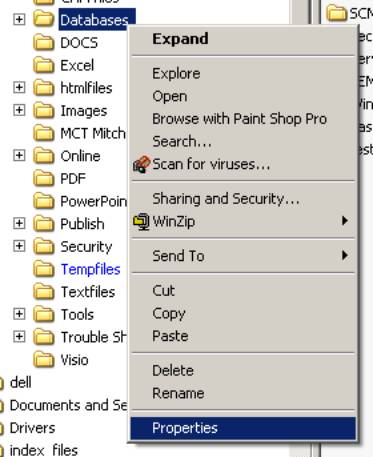
On the GENERAL tab of the properties folio you would select the Advanced push button in club to bring up the Avant-garde Attributes page, equally shown below.
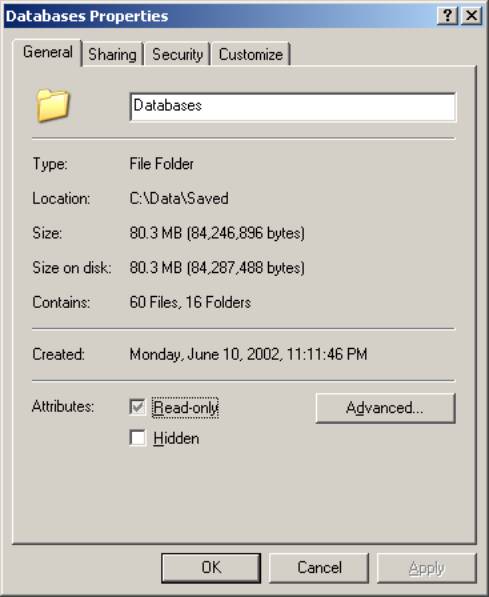
On the Advanced Attributes folio y'all would go down to the Compress or Encrypt attributes section where you can choose 1 checkbox to compress the contents or the other to encrypt them.
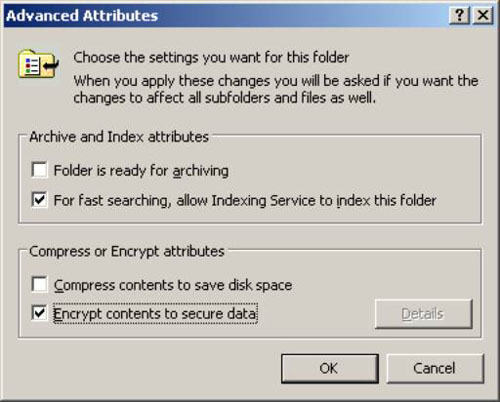
[NOTES FROM THE FIELD] - Strangely enough, the options to target are bank check boxes, which ordinarily denote the ability to choose more than one selection. (Radio buttons are normally used in a situation where only one pick from a number of given ones can be selected.) Regardless of which, if you attempt to select both, you will notice that your second choice in this section undoes your first selection.
I think the conclusion to program this property folio in this style stems from the fact that you cannot unselect a radio push button past clicking on information technology a second time as you lot can a checkbox. (This is just my thought on this. This is not backed up by any facts.) If y'all want to make a folder and the contents "normal" by neither encrypting them nor compressing them, you'd clear the checkboxes.
Once y'all elect to encrypt the folder by selecting that checkbox y'all would click OK and it would seem as if goose egg has happened, and actually, cipher has. Until you click APPLY or OK to the primary belongings sail, you will not be given whatever farther options for this performance.
At that fourth dimension, the next options are available every bit shown below.
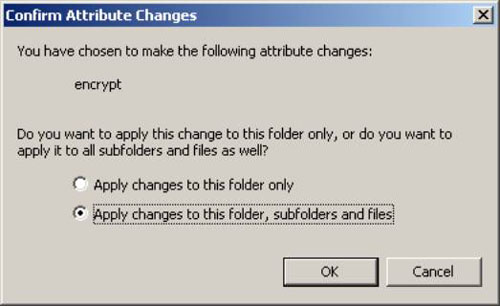
If y'all elect to apply changes to the folder only, only the folder itself will become encrypted. What this ways is that anything currently in the folder volition keep its current land which is unencrypted. Anything added to that folder from that point frontward volition get encrypted as it is copied to or moved to the binder.
One time you lot hit OK you will see the progress of the encryption attribute being prepare on all the files and subfolders as you take selected.
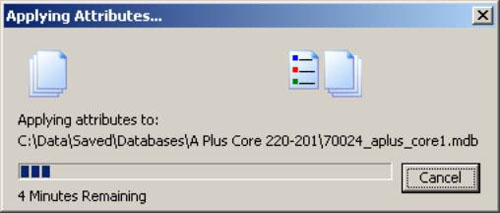
[NOTES FROM THE FIELD] - Any encrypted file that is moved to or copied to a compressed folder will remain encrypted and will NOT become compressed and hence unencrypted.

If the encrypted file that was moved to that folder is correct clicked and has the encryption attribute removed it will Not become compressed automatically.

The only way to compress that file is to individually right click it and cull to compress information technology or to Motility information technology out of and and so back into the folder AFTER the encryption bit has been turned off for that file. Simply copying information technology out to a temporary location and so dorsum in with the OVERWRITE option will NOT cause it to become compressed even if changes were fabricated to the copied out version.
This ways that if an encrypted document is unencrypted in a compressed folder it will be in a normal land, (not encrypted nor compressed). If another copy of that document exists somewhere else on the system and it is in a compressed land and editing is performed on that copy and then saved at that location of the hard drive and then that compressed and updated re-create is copied over the older version, that older version volition still be uncompressed in that folder that is supposed to compress all new files that are copied in. The updates to the text will be nowadays, but the file will notwithstanding be uncompressed.
This is considering the attributes to the file are not carried over with the changes to the file itself.
This likewise works for the reverse, from not compressed to compressed.
If you elect to apply changes to the binder and all of the files and subfolders contained within the binder, they volition all go encrypted.
If you elect to remove encryption from the folder itself and choose to make the attribute changes to the folder but, all the files in the folder that were encrypted before will remain encrypted and if y'all copy them within the partitioning those private files volition remain encrypted. All new files copied to or created in that binder will no longer accept the encryption bit ready.
When y'all issue changes to the folder and all of the files subfolders independent within, all of the files will go decrypted.

[NOTES FROM THE FIELD] - If there is a file within the folder that is to be uncompressed that is in an encrypted state, it will stay encrypted equally the encrypted attribute of that file is non affected by the clearing of the compression attributes of the other files around it and the fold it's in.
Y'all can select to view compressed and encrypted files in different colors and then that yous know the state of the file by quickly looking at it.
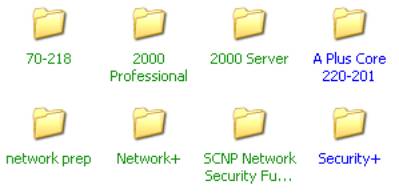
[NOTES FROM THE FIELD] - In the instance to a higher place, the folders denoted in bluish lettering are compressed and the ones in green lettering are encrypted. This can be set up by going in to the Windows Explorer and choosing Tools and so Folder Options.
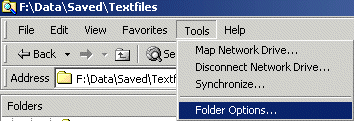
On the View tab of the pop up box is where you lot would select the Evidence encrypted of compressed NTFS files in color checkbox to enable this feature.
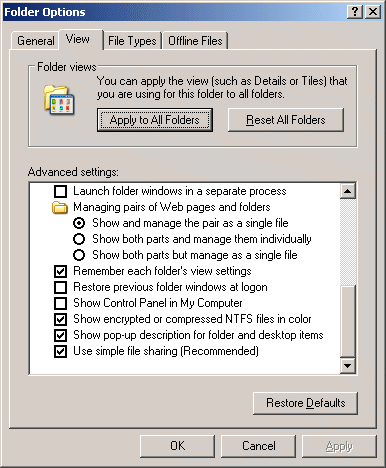
If you copy an attribute prepare encrypted file to a FAT16 or a FAT32 partition or to a floppy disk, it will lose its encryption attribute.
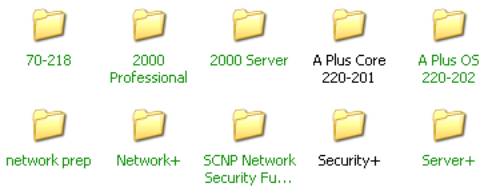
Strangely enough, when y'all perform this same action under Windows 2000 you will not receive this message. You lot will simply be able to perform your activeness without the warning.
The overall rules for encryption are equally follows (and they are different than compression):
- When moving or copying a file inside the aforementioned NTFS book an encrypted file will not inherit the encryption state of the target binder when that folder is unencrypted. When you copy or move an encrypted file to an unencrypted folder, the file is still encrypted. If you accept enabled a folder to encrypt files and you lot move or re-create an unencrypted file to it, it volition go encrypted at that signal.
- When copying or moving a file or folder from one NTFS book to another an encrypted file will non inherit the encryption state of the target folder when that binder is unencrypted. When you copy or motion an encrypted file to an unencrypted folder, the file is still encrypted. If you have enabled a folder to encrypt files and you lot move or copy an unencrypted file to it, across partitions, it will get encrypted at that point.
- Moving or copying a file or folder to a FAT16 or FAT32 book - Windows XP Professional person supports attribute driven encryption only on the NTFS file arrangement, and then when y'all motility or re-create an encrypted NTFS file or folder to a Fat volume, (12, xvi or 32) the encryption attribute will exist lost.
- Moving or copying a compressed file or folder to a floppy disk or other removable media - Windows XP Professional supports attribute driven encryption only on the NTFS file system, and then when you move or re-create an encrypted NTFS file or folder to nigh types of removable media, the encryption attribute will be lost because most forms of removable media exercise not support the NTFS file organisation.

The unencrypted folders are shown in black text.
If you accept any questions, comments or even constructive criticism, please feel free to drop me a note.
| Sponsors |
 |
Source: https://www.mcmcse.com/microsoft/guides/compression.shtml
0 Response to "what does it mean to compress os drive"
Post a Comment